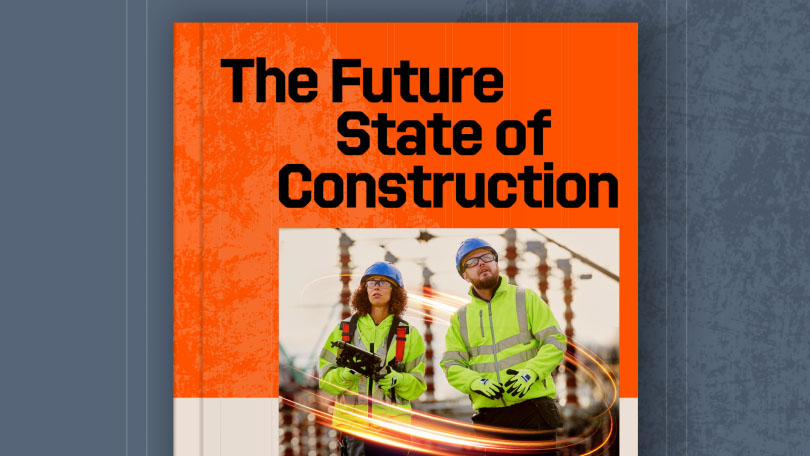— 18 min read
The Preconstruction Phase: A Deep Dive into the Pre-con Process


Last Updated Aug 20, 2025

Janine Trinidad
Staff Trainer and Program Manager
25 articles
Janine Trinidad is a Construction Educational professional for Procore Technologies. In previous roles, Janine managed all phases of construction on hotel, mixed-use, and institutional projects in the San Francisco Bay area. She was responsible for negotiating contract budgets and change orders, managing RFIs and submittals, and overseeing quality control, among other duties. She is also a certified transformational coach with a focus on women-centered and trauma-informed methods. She is passionate about transforming the construction industry to be a healthier, more successful and welcoming place to work and believes technology and education are allies in doing so.

Daniel Gray
Contributing Writer
32 articles
Daniel is an educator and writer with a speciality in construction. He has been writing construction content for Procore since 2022, and previously served as a Procore Content Manager before continuing to pursue an education career as an Assistant Headmaster for Valor Education in Austin. Daniel's experience writing for construction — as well as several clients under an agency — has broadened his knowledge and expertise across multiple subjects.

Nicholas Dunbar
Content Manager
62 articles
Nick Dunbar oversees the creation and management of UK and Ireland educational content at Procore. Previously, he worked as a sustainability writer at the Building Research Establishment and served as a sustainability consultant within the built environment sector. Nick holds degrees in industrial sustainability and environmental sciences and lives in Camden, London.
Last Updated Aug 20, 2025

Preconstruction is the strategic phase of a construction project that bridges the gap between the initial plans drawn up in the pre-development stage and the physical activities associated with work on site. This phase refines broad project ideas into concrete plans that balance cost efficiency and quality while identifying and mitigating potential risks.
Table of contents
What Is Preconstruction?
Preconstruction also fulfils duties set out in legislation such as the Construction (Design and Management) Regulations 2015 (CDM 2015). Early engagement helps clients, designers and main contractors (MCs) satisfy legal obligations, secure Planning Permission and Building Regulations approval, and control costs long before the first spade enters the ground.
Defining Preconstruction
The essence of preconstruction is to transform broad strokes into fine details. You may find project managers collaborating closely with architects to fine-tune designs, cost planners developing detailed budgets, or construction managers identifying potential safety hazards and devising robust mitigation plans.
Below, we examine why project owners and contractors focus so heavily on a thorough preconstruction process when aiming for a successful construction phase.
Importance of Preconstruction
Preconstruction is the foundation that takes a construction project from idea to built reality. During this phase, owners, project managers, architects, engineers and other stakeholders tackle important questions, including:
- Have we fully refined the design to account for all practicalities of construction?
- Which main contractor is most suitable for our specific project requirements?
- How do we efficiently organise resources and mobilise for construction?
- How can we best anticipate and mitigate potential risks, both in terms of safety and cost?
- What are the realistic timelines—or programmes—for each phase of construction?
- Have we obtained all necessary permits, including Planning Permission and Building Regulations approval?
Addressing these questions enables the project team to avoid roadblocks and ensure that the project gets off to a smooth start.
The work that happens during preconstruction sets the stage for later success—or failure. Projects with shaky budgets, poor risk-mitigation tactics, incomplete site assessments and negligent designs frequently break ground, but they rarely make it through construction unscathed. Variation orders, financing problems and differing site conditions are virtually guaranteed to arise. Experienced developers and construction professionals know that projects live and die according to preconstruction management.
The Preconstruction Team
Before preconstruction begins, the client or developer assembles the team that will prepare the project. The actual professionals and companies involved will vary by project type, size and complexity.
Owner or Developer
Sets the objectives, budget and success criteria. Larger developers may appoint an owner’s representative or project manager to steer the process.
Design Team
Responsible for designing every detail of the project.
- Architects / Lead Designers – develop preliminary and detailed designs.
- Civil Engineers – provide site analysis (drainage, access, surveys).
- Structural Engineers – ensure the structure is sound.
- MEP Engineers – design services and building systems.
Main Contractor / Construction Manager
Clients often bring in a main contractor (MC) early to advise on buildability, cost and programme. (For simplicity, we use the term MC to include roles a construction manager may perform.)
Specialist subcontractors—plumbing, electrical, HVAC—may also contribute during preconstruction.
This is by no means an exhaustive list. Many other players may be involved, including legal counsel, environmental consultants, government representatives, and more. A savvy owner will identify the knowledge gaps or needs as they build the preconstruction team to ensure they hire professionals with the right experience and skill sets for the job.
Key Activities in Preconstruction
During preconstruction, the project owner assembles the project team that will produce with architects, engineers, contractors, and other construction professionals to take a project from conception to construction. Before preconstruction begins, a project owner will have already completed key predevelopment tasks like feasibility studies, site assessment, land acquisition, financing, and preliminary design.
At that point, the focus shifts to further developing the design, selecting contractors, accounting for risk, and mobilising for construction. To kick off this phase of a project, the owner or project manager often holds a preconstruction meeting with the key stakeholders to establish roles and responsibilities and clarify expectations.
| Activity | Definition | Key Considerations |
| Design Development | Refine designs into construction drawings and specifications. | Must align with RIBA Plan of Work stages and UK Building Regulations. |
| Contractor Bidding & Selection | Solicit bids, assess MC qualifications, agree contract. | Often uses JCT or NEC contract forms; selective tendering common. |
| Risk Analysis & Mitigation | Identify cost, safety and programme risks. | CDM 2015 duties; include Principal Designer risk workshops. |
| Project Programme | Develop a detailed programme with dependencies. | Use CPM; align with Section 106/278 obligations if applicable. |
| Permitting | Secure Planning Permission, Building Regulations approval, Listed-Building Consent (if needed). | Engage local planning authority; Party Wall etc. Act 1996 may apply. |
| Construction Mobilisation | Set up site, workforce and logistics. | Prepare Construction Phase Plan and welfare facilities per CDM. |
We explore each activity in more detail below.
Design Development
Design development is the process of refining the preliminary concept into a collection of project specifications and drawings that detail the design, materials, methods, and standards required for construction. This process involves the collaboration of architects, engineers, interior designers, and potentially contractors with certain project delivery methods, like design-build (DB). Design development finds a balance between creative vision and technical or financial feasibility through several stages: architectural design, engineering design, interior design, and design review.
| Activity | Description |
| Architectural Design | The design team, led by the architect, develops comprehensive architectural plans outlining the project’s look, functionality, and structure. |
| Engineering Design | The engineering team creates structural, mechanical, electrical, and plumbing designs, ensuring the building will be sound, efficient, and in compliance with legislation. |
| Interior Design | The interior design team plans the indoor spaces, considering aesthetics, functionality, and occupant needs. |
| Design Review and Revisions | The design is reviewed and refined, taking into account feedback from various stakeholders, ensuring the design meets all project requirements. |
The architectural design phase involves creating drawings that visually depict the project’s concept, layout, and structure. The design team then expands upon these schematics to develop detailed construction drawings. These documents provide in-depth information about the design and are essential in guiding the subsequent construction process.
Next, the engineering design process ensues. Specialists in structural, mechanical, electrical, and plumbing engineering ensure the building’s robustness, efficiency, and regulatory compliance. A key aspect of this phase is creating project specifications, which detail materials, standards, and methods for the project’s construction.
Interior design is an integral component of the design development phase as it pertains to crafting functional, aesthetically pleasing indoor environments. Here, the focus is on the eventual occupant’s experience, comfort, and productivity within the space.
Design Review
Throughout the design development phase, an iterative process of design review and revisions unfolds. Stakeholders, including the project owner, potential tenants, regulatory authorities, and community representatives, can provide valuable input, leading to design enhancements. This process is instrumental in achieving a design that aligns with the project’s budget, constraints, local regulations, and objectives.
Contractors can also engage in design review as a design-assist contractor. This gives the architect and project owner valuable input, such as the constructability of the design, installation, and cost estimating.
Many projects use value engineering during the design development phase. Value engineers use a methodical review process to identify and remove unnecessary costs while ensuring the design meets the desired quality and functionality. Budgetary constraints inform and shape the design process from the beginning, ensuring the final design is economically viable without compromising on value.
Another increasingly common aspect of modern design development is the creation of a Building Information Modeling (BIM) model. BIM is a 3D model-based process that gives architecture, engineering, and construction (AEC) professionals the tools to efficiently plan, design, construct, and manage buildings and infrastructure.
A BIM provides a digital representation of the building’s physical and functional characteristics, enabling teams to anticipate and address potential issues before construction begins. BIM is a potent tool that enhances visualisation, improves collaboration, and promotes better decision-making throughout the construction process.
At the culmination of the design development phase, the project team will have a comprehensive design, constrained and honed by budget considerations, regulatory compliance, and stakeholder feedback. With a solid design in place, the project owner is ready to select contractors, moving closer to the construction process.
Contractor Selection
After finalising the project’s design, a project owner will seek to find a qualified main contractor to build the design. Typically, this involves using some combination of a Request for Quotations (RFQ), or a Request for Proposals (RFP).
For contractors, this phase requires an understanding of the project (typically a short amount of time) to provide detailed cost estimation, and the development of a competitive bid.
| Activity | Description |
| Issuing and Responding to RFQs or RFPs | The project owner issues an RFQ, and contractors respond with their qualifications or a detailed proposal, demonstrating their capability to deliver the project. |
| Selective or Negotiated Bidding | The owner may invite select contractors or negotiate with a preferred contractor to submit bids for the project. |
| Cost Estimation | Contractors analyse the project’s scope, labour, materials, and overheads to provide a comprehensive cost estimate. |
| Bid Preparation | Contractors create detailed bids outlining their proposed approach, cost, and timeline for the project. |
| Bid Evaluation and Leveling | The owner evaluates bids, considering factors such as cost, contractor experience, proposed schedule, and approach. Bids are “leveled” to ensure accurate comparison. |
| Contract Negotiation | The owner and the selected contractor negotiate terms and conditions of the contract. |
The construction bidding process often begins with the owner issuing an RFQ or an RFP, soliciting contractors to demonstrate their ability to carry out the project based on their past performance, expertise, and financial stability. Contractors must have a deep understanding of the project’s requirements and express their qualifications — often related to a specific proposal, record of past successful projects, safety record, and financial stability.
Depending on the type of project, the goals of the owner, and existing relationships with contractors, the owner can choose from several different types of bidding. While open bidding is typically required on public projects of a certain size, owners on private commercial projects often prefer selective or negotiated bidding. This allows them to approach contractors they trust or negotiate directly with a preferred contractor, often ensuring a higher quality of work. As a contractor, being on the shortlist for selective bidding often indicates a strong reputation and trust in the industry.
Cost estimation is an essential part of a contractor’s process of writing a bid. Contractors analyse the scope of the project, the labour required, the cost of materials, equipment, overhead, contingency, and profit margin to arrive at an accurate cost estimate. A well-crafted cost estimate can demonstrate a contractor’s understanding of the project and their ability to deliver it within the owner’s budget.
Once the cost estimate is complete, the contractor creates a bid that outlines their proposed approach, cost, and timeline for the project. It should detail how they plan to execute the project, their estimated costs, and when they expect to complete the project.
During bid evaluation and leveling, the owner scrutinises the bids to select the best contractor for the project. They compare bids on various factors, such as cost, experience, proposed schedule, and proposed approach — though price tends to be the definitive factor. Leveling the bids ensures a fair comparison by normalising for differences in how contractors might have interpreted the project scope.
Finally, the project owner awards the contract to a specific contract and contract negotiation occurs. This involves finalising the contract’s terms and conditions, such as payment terms, project timeline, and scope of work. It’s a chance for both parties to align their expectations and agree on how the project will proceed.
Risk Analysis and Mitigation
Risk analysis and mitigation help the project team anticipate potential issues, assess their impact, and develop plans to mitigate negative effects on the project. The main contractor or construction manager typically performs these activities to plan for cost control, site-specific safety measures, and quality control.
| Activity | Description |
| Risk Identification and Assessment | The team systematically identifies potential risks and evaluates their possible impact on the project’s objectives. |
| Cost Control Planning | A strategy is developed to monitor and control the budget, preventing cost overruns and ensuring financial performance aligns with the project’s goals. |
| Site-specific Safety Planning | The team prepares a safety plan tailored to the specific conditions and risks of the construction site, aiming to prevent accidents and ensure regulatory compliance. |
| Quality Control Planning | A quality control plan is created to maintain the project’s standards, prevent defects, and ensure the final deliverables meet the project’s objectives and the owner’s expectations |
| Risk Response Planning | The team prepares responses to many kinds of potential risks, which could include avoiding, transferring, mitigating, or accepting risks. |
Risk analysis starts with risk identification and assessment. This involves a systematic process to detect potential risks that could impact the project and evaluate their likelihood and possible impact. This comprehensive risk review covers everything from budget and schedule risks to design, legal, regulatory, safety, and environmental risks.
Next, cost control planning involves developing strategies to monitor and control costs throughout the project. This goes beyond merely tracking expenses — it encompasses forecasting, variance analysis, and change control to keep the project within budget and prevent cost overruns. By controlling costs effectively, the project team can ensure that the project’s financial performance aligns with the budget — and maintains profitability for all parties.
Site-specific safety planning is the process of developing a safety plan that takes into account the unique conditions and potential hazards of the construction site. This safety plan is designed to prevent accidents, ensure the wellbeing of workers, and meet regulatory requirements. It includes protocols for proper use of safety equipment, handling hazardous materials, emergency response, and training.
Quality control planning involves the creation of a plan to maintain quality standards throughout the project. It aims to prevent defects, reduce rework and ensure that the final project deliverables align with the project’s objectives and the owner’s expectations. This might involve setting quality targets, defining inspection and testing procedures, and establishing a process for handling defects and changes.
Finally, risk response planning involves preparing strategies to deal with identified risks. The team might choose to avoid, transfer, mitigate, or accept risks, depending on their potential impact and the project’s risk tolerance. This response planning helps ensure the team is prepared to proactively address risks and maintain control over the project’s outcomes.
Project Programme
The MC produces a detailed project programme that lays out the timeline of all tasks necessary to complete the project, taking into consideration dependencies (i.e. tasks that must be finished before others), the resources required, and potential risks.
The schedule serves as the project’s roadmap, guiding all involved parties throughout the project’s lifecycle.
Activity | Description |
| Developing Work Breakdown Structure (WBS) | The team defines the project’s scope into manageable tasks, providing a foundation for detailed scheduling and resource allocation. |
| Selecting Programme Methodology | A project scheduling methodology, like Critical Path Method (CPM) is selected based on the project’s needs. |
| Identifying the Critical Path | The sequence of project activities with the longest duration is determined, highlighting tasks that can’t be delayed without affecting the project turnover date. |
| Resource Allocation Planning | Resources such as labour, materials, and equipment are assigned to each task, ensuring their availability aligns with the project programme. |
| Risk Assessment in Scheduling | Potential risks are identified and assessed, allowing for contingency planning in the schedule. |
| Visualising Construction Promgrammes | The team develops visual representations of the programme, such as Gantt charts or network diagrams, to clearly communicate the project timeline and dependencies. |
A well-planned project schedule begins with the development of a Work Breakdown Structure (WBS). This process breaks down the project’s scope into manageable tasks, providing a clear foundation for the programme and resource allocation. Each activity is then linked with the necessary resources and dependencies to form a cohesive project timeline.
Identifying the critical path involves outlining the sequence of dependent tasks that takes the longest time to complete. As these tasks directly impact the project’s finish date, any delay on the critical path will inevitably delay the whole project. Understanding the critical path allows project managers to focus on managing these crucial tasks effectively.
Resource allocation planning is the process of assigning resources — such as labour, materials, and equipment — to each task in the programme. This ensures that the necessary resources are available when needed, preventing schedule delays due to resource shortages.
Risk assessment in scheduling involves identifying and evaluating potential risks that could impact the project schedule. This could include unforeseen delays, changes in scope, or resource availability issues. Risk assessment helps the team develop contingency plans and buffer times in the schedule, allowing for more accurate and realistic project timelines.
The team can visualise the project schedule using tools like Gantt charts or network diagrams. These visualisations provide a clear picture of the project timeline, task dependencies, and progress, making it easier for all stakeholders to understand the project’s status and expectations.
Finally, the project team chooses an appropriate scheduling methodology. Methods like the Critical Path Method (CPM) or Program Evaluation and Review Technique (PERT) provide structured frameworks for creating and managing the project schedule.
Permitting
Obtaining proper approvals ensures the project complies with all relevant UK legislation and codes.
| Activity | Description |
| Pre-application Advice | Engage the local planning authority to clarify requirements and fees. |
| Application Preparation & Submission | Submit full plans, heritage statements, ecological surveys, etc. via the Planning Portal. |
| Planning Permission | Most UK projects require full Planning Permission; outline conditions early to avoid delays. |
| Building Regulations Approval | Secure approval through the local authority or an Approved Inspector. |
| Party Wall etc. Act 1996 | Issue notices and agree awards where neighbouring structures are affected. |
| Listed-Building Consent (if applicable) | Required for alterations to listed properties. |
Failure to obtain these approvals can halt works and incur penalties.
Construction Mobilisation
Construction mobilisation marks the transition from preconstruction to the physical start of work on site. This process involves preparing the construction site, assembling the construction team, arranging necessary equipment and materials, setting up site facilities, and ensuring proper safety measures are in place.
| Activity | Description |
| Site Preparation | Prepare the site for construction by clearing, grading, setting boundaries, and implementing necessary erosion and sediment control measures. |
| Team Mobilisation | Assemble the on-site construction team, including key personnel like the project manager, site supervisor, and safety manager. |
| Equipment and Materials | Arrange necessary construction equipment and materials on site. |
| Site Facilities Setup | Set up site offices, temporary utilities, staging areas, worker facilities, and safety installations. |
| Safety Measures | Implement necessary safety measures including safety signage, fencing, safety equipment, and fire brigade connection. |
Site preparation is the first step in mobilisation. This typically involves clearing the site, removing any existing structures, grading the site for drainage, setting site boundaries, preparing access for equipment and materials, and implementing necessary erosion and sediment control measures. This process prepares the ground for the upcoming construction activities and helps to minimise potential site-related risks.
Next, team mobilisation takes place. Key members of the construction team, such as the project manager, site supervisor, safety manager, and various trade personnel, are assembled on site. These individuals are instrumental in coordinating and managing construction activities and ensuring a safe and efficient work environment.
In tandem with team mobilisation, the project sees the arrival of equipment and materials. The necessary construction machinery and equipment are brought to site, and arrangements for material delivery are coordinated to align with the construction schedule. Proper planning here ensures that work can proceed without unnecessary delays.
Site facilities setup involves establishing temporary facilities needed to support construction activities. This can include site offices, storage areas, worker facilities like restrooms and break areas, and any necessary safety installations.
Lastly, the team will put in place necessary safety measures and procedures to protect workers and the public. This includes safety signage, fencing to secure the construction site, and the provision of personal protective equipment (PPE) for the workers. A site-specific safety plan is implemented, which outlines procedures for safe work practices, emergency response, and ongoing safety training.
Pre-Construction Information & UK Regulations (CDM 2015)
Under the Construction (Design and Management) Regulations 2015, the client and Principal Designer must compile a Pre-Construction Information (PCI) pack outlining site risks, surveys and welfare arrangements before work starts. Sharing robust PCI enables the Principal Contractor to prepare a CDM-compliant Construction Phase Plan and enhances overall site safety.
Typical UK preconstruction deliverables include:
- RIBA Stage 4 design set
- Cost Plan Level 3
- Project risk register
- Pre-Construction Information (PCI) pack
- Draft Construction Phase Plan
Site Safety in Preconstruction
Early hazard workshops allow the project team to eliminate or design-out risks and set measurable safety targets. Aligning with HSE guidance during preconstruction reduces incident rates once construction is under way.
Transitioning Seamlessly from Preconstruction to Construction
The preconstruction phase is a critical juncture to lay the groundwork for successful project completion. Elements like design development, contractor selection, risk analysis, project scheduling, permitting, and construction mobilisation require careful planning, rigorous analysis, and thoughtful decision-making.
Effective preconstruction mitigates risk, boosts programme efficiency and creates a data trail that improves forecasting across your portfolio. A single project-management platform such as Procore maintains this data from concept to handover, providing one source of truth for site and office teams alike.
With this information at their fingertips, project teams can stay on track, maintaining timelines and budgets while delivering the quality specified in the project plans
Frequently Asked Questions
What happens during preconstruction?
The team finalises designs, agrees budgets, secures permissions and prepares the site.
How does preconstruction differ from construction?
Preconstruction focuses on planning and approvals; construction executes the approved plan on site.
What is a Pre-Construction Phase Plan?
A document prepared by the Principal Contractor under CDM 2015, setting out site-specific safety arrangements before work starts.
How long does the preconstruction phase take?
Most UK commercial projects spend 10–20 % of the total programme in preconstruction, but complex schemes (e.g. data centres) may require up to 12 months.
Categories:
Written by

Janine Trinidad
Staff Trainer and Program Manager | Procore Technologies
25 articles
Janine Trinidad is a Construction Educational professional for Procore Technologies. In previous roles, Janine managed all phases of construction on hotel, mixed-use, and institutional projects in the San Francisco Bay area. She was responsible for negotiating contract budgets and change orders, managing RFIs and submittals, and overseeing quality control, among other duties. She is also a certified transformational coach with a focus on women-centered and trauma-informed methods. She is passionate about transforming the construction industry to be a healthier, more successful and welcoming place to work and believes technology and education are allies in doing so.
View profile
Daniel Gray
Contributing Writer
32 articles
Daniel is an educator and writer with a speciality in construction. He has been writing construction content for Procore since 2022, and previously served as a Procore Content Manager before continuing to pursue an education career as an Assistant Headmaster for Valor Education in Austin. Daniel's experience writing for construction — as well as several clients under an agency — has broadened his knowledge and expertise across multiple subjects.
View profileReviewed by

Nicholas Dunbar
Content Manager | Procore
62 articles
Nick Dunbar oversees the creation and management of UK and Ireland educational content at Procore. Previously, he worked as a sustainability writer at the Building Research Establishment and served as a sustainability consultant within the built environment sector. Nick holds degrees in industrial sustainability and environmental sciences and lives in Camden, London.
View profileExplore more helpful resources

Construction Management Contracts: A Complete UK Guide
Managing construction contracts can lead to an extensive physical paper trail. Sharing contracts, getting signatures and managing timelines is difficult when teams and clients are scattered across job sites and...

Key Differences Between Contractors & Subcontractors
In UK commercial construction, main (or principal) contractors engage directly with project owners to deliver complete construction programmes, while subcontractors perform specific scopes of work under the main contractor’s management....

The Role of RFPs in UK Construction Projects
Requests for Proposals (RFPs) are a core document for construction procurement in the United Kingdom. Effective RFPs align expectations, establish clear evaluation criteria, and create accountability between clients and contractors....

Financial Management in Construction Projects
Effective financial management can make or break construction projects. Teams that master budgeting, cash flow and cost control are better positioned to deliver projects on time, within budget and with...
